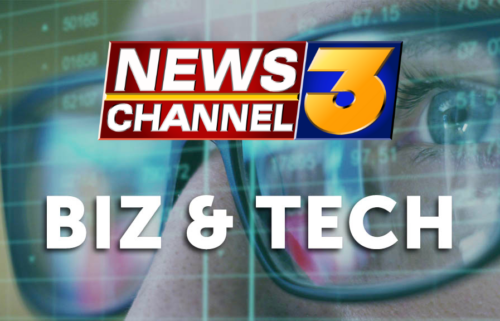Stocks rally on Wall Street as bank fears ease further

By STAN CHOE
AP Business Writer
NEW YORK (AP) — Stocks are rallying Wednesday as Wall Street shakes off more of the fear that dominated it earlier this month.
The S&P 500 was 1.3% higher in late trading. The Dow Jones Industrial Average was up 273 points, or 0.8%, at 32,667, as of 3:15 p.m. Eastern time, while the Nasdaq composite was 1.7% higher.
They followed similar sized gains in other markets around the world, and the S&P 500 is on track to close what’s been a tumultuous month with a modest gain. That’s despite the month being dominated by worries about banks and whether the industry is cracking under the pressure of much higher interest rates.
Forceful actions by regulators have helped to calm some of the worries about banks. By Wednesday, a measure of fear among stock investors fell back toward its lowest point since March 9. That’s the day Silicon Valley Bank’s customers suddenly yanked out $42 billion in a panicked dash. It became the second-largest U.S. bank failure in history and sparked harsher scrutiny of banks around the world.
“I think the market has been very much focused on a set of extremes, like what we saw in the COVID period, where it was either: The sky is falling, or everything is euphoric,” said Zach Hill, head of portfolio management at Horizon Investments.
While he doesn’t think fears about banks are completely gone, he says now “we’re in much more of a middle ground environment, in terms of the economy and in terms of rate hikes flowing through to economic activity.”
Among the big actions taken by regulators was a government-brokered takeover by one Swiss banking giant of another. In that deal, UBS said Wednesday it’s bringing back former CEO Sergio Ermotti to help it absorb its troubled rival, Credit Suisse. Ermotti led the bank through its turnaround following the 2008 financial crisis.
UBS stock in Switzerland rose 3.7%. Other big banks across the continent also strengthened, which helped indexes there to rise 1% or more.
On Wall Street, the vast majority of financial stocks in the S&P 500 rose. In the U.S., most of the scrutiny has been on smaller and midsized banks that are seen as more at risk of a sudden exodus of customers, similar to the run that toppled Silicon Valley Bank.
Some of the banks recently at the center of Wall Street’s hunt for similar banks rose sharply. First Republic Bank jumped 4.9%, and PacWest Bancorp. gained 5.9%.
The Federal Deposit Insurance Corp. announced the sale of much of Silicon Valley Bank’s assets at the start of this week. Regulators earlier this month also announced programs to help banks raise cash more easily. That, plus the implicit promise U.S. officials have seemed to make about protecting depositors at other banks, should help support the industry, analysts say.
Easing fears about the banking system have helped Treasury yields to steady somewhat in the bond market, following some historic-sized moves earlier this month.
The two-year Treasury yield, which tends to moves on expectations for the Fed and has been particularly unsettled, was holding steady at 4.08%. Earlier this month, it went from more than 5% to less than 3.80%, which is a massive move.
The path ahead for the Federal Reserve and other central banks has suddenly become much more difficult because of the banking industry’s struggles. Typically, the still-high inflation seen around the world would call for even higher interest rates. But that would risk applying more pressure on banks, which could pull back on lending and squeeze oxygen out of the economy.
Traders are largely betting the Fed will have to cut rates as soon as this summer, something that can act like steroids for markets. That’s helped Big Tech and other high-growth stocks in particular, which are seen as benefiting the most from lower rates.
It’s also why a quick glance at the index that gets the most attention on Wall Street could be deceiving, Hill said.
“Looking just at the S&P 500, you could potentially draw wrong conclusions from that,” he said. “The rotations beneath the surface, we think it makes some sense.”
Gains for Big Tech stocks, which dominate the top of the S&P 500, have helped buoy that index. But smaller stocks are still down sharply for the month, as are financial stocks.
The Fed has been hinting it sees perhaps one more hike before holding rates steady through this year. Many professionals on Wall Street are taking the Fed at its word, saying rate cuts would likely come more quickly only if the economy is in serious trouble.
For now, a remarkably resilient job market has been holding up the economy, even as portions of it weaken under the strain of higher interest rates. Companies will soon begin reporting how much profit they made in the first three months of the year under such conditions.
Analysts expect a 6% drop in earnings per share for companies in the S&P 500 index, versus year-earlier levels. That would be the worst showing since the spring of 2020, at the height of the pandemic.
Lululemon jumped 12.8% after the athletic apparel company reported stronger profit and revenue for its latest quarter than expected.
Micron Technology on Wednesday rose 7.1% even though it reported a bigger loss and weaker revenue for its latest quarter than expected. Analysts said they were expecting a rough quarter, and they see some signs of optimism on the horizon as bloated inventories in the industry appear to be working down.
___
AP Business Writers Joe McDonald and Matt Ott contributed.
